People in central Venezuela are losing electricity service regularly.
The lack of power means Venezuelans cannot cool their homes during a heat wave. Lack of electricity also means that factories, homes and basic service providers, or utilities, have no power.
Citizens, engineers, and researchers say electricity producing stations are failing to provide enough electricity when hydroelectric dams have low water levels.
"It is inhumane that in a city like this they cut our power during the hottest hours," said 42-year-old Mariana Barboza in Maracaibo, where temperatures can reach 40 degrees Celsius.
Reuters news service says long power cuts had been avoided in recent years because demand has dropped sharply. Also, President Nicolas Maduro’s government has aimed to improve power lines. But outages have returned. Now, they are affecting the capital Caracas, which had not experienced them too often in the past.
People from Caracas said the cuts last for at least four hours a day. Maduro said recently that Venezuela’s average temperature rose four degrees Celsius this year.
During part of the year, electricity-producing dams have reduced water flow while demand for electricity to cool homes increases. This has led to reports of a public water supply that is not always available, and unstable electricity at factories and oil operations. There have also been times when telecommunications services are unavailable.
The city of Maracaibo is the capital of Zulia, a state in the west of the country. Reuters reported that some public hospitals in the state were told to begin operating their own power stations. That is because the local government cannot secure dependable power. A person with knowledge of the plan spoke to the news agency.
Venezuela’s information ministry and state power company Corpoelec did not answer requests for comment by Reuters.
No water, no power
Venezuela’s main power supply comes from the Guri Dam in the south of the country. But the dam produces less electricity when water levels are low before the rainy season.
In 2019, Venezuela’s power transport system collapsed. It left almost the whole country without electricity for four days.
The government has made improvements to the power transportation lines since then to avoid a similar crisis. But researchers say that even some of the recently built fuel-powered plants are out of service because of a lack of fuel, delayed repairs, and lack of replacement parts.
That leaves the power system at risk of outages whenever demand is above the 12,000 Megawatts (MW) usually produced by the Guri Dam. In May, independent estimates showed that the daily demand for electricity reached almost 13,000 Megawatts.
However, that number is down from the 19,000 Megawatts that used to be needed 10 years ago.
"Even being robust, the Guri also gets tired," said engineer Isnaldo Jimenez from the Association of Electricians and Mechanics in Carabobo state. He was talking about the high demand for electricity from the dam when other plants cannot provide enough power.
State oil company PDVSA is struggling to meet the country’s fuel needs for electricity production and gasoline stations. The company also faces restrictions from the U.S. government.
But even with more fuel, plants would not operate up to their abilities because the electricity system needs $15 billion in development to overcome central problems, said Juan Carlos Rodriguez. He is with the business advice company JCR Engineers.
The system’s lack of dependability has not stopped the government from increasing electricity costs for buyers.
"We cannot catch a breath," said 62-year-old vegetable seller Augusto Gonzalez in Maracaibo. "I arrive in my shop every day to try to sell something, but if power was cut in the middle of the night, we lose our produce."
I’m Gregory Stachel.

